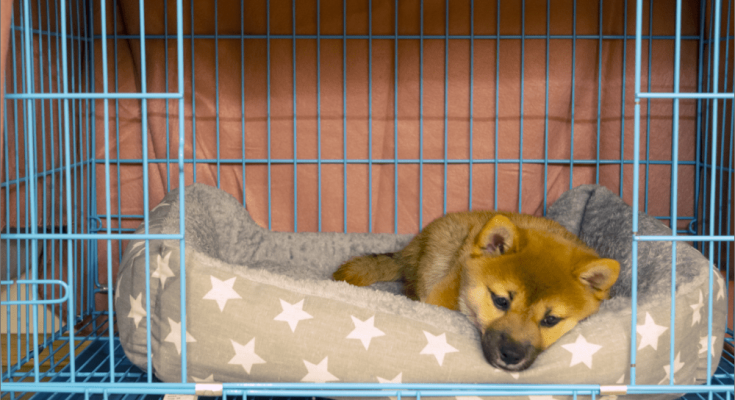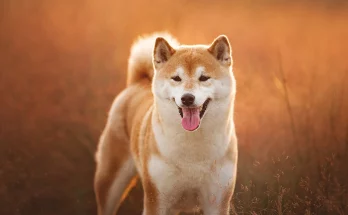Shiba Inus are adorable and spirited dogs that make wonderful companions. If you’ve recently welcomed a Shiba Inu puppy into your home, it’s crucial to start their training early on. One essential aspect of their training is crate training. Crate training provides a safe and comfortable space for your Shiba Inu while also aiding in potty training and preventing destructive behavior. In this article, we will guide you through the process of crate training a Shiba Inu puppy, step by step, ensuring a positive and successful training experience for both you and your furry friend.
Understanding Crate Training: The Basics
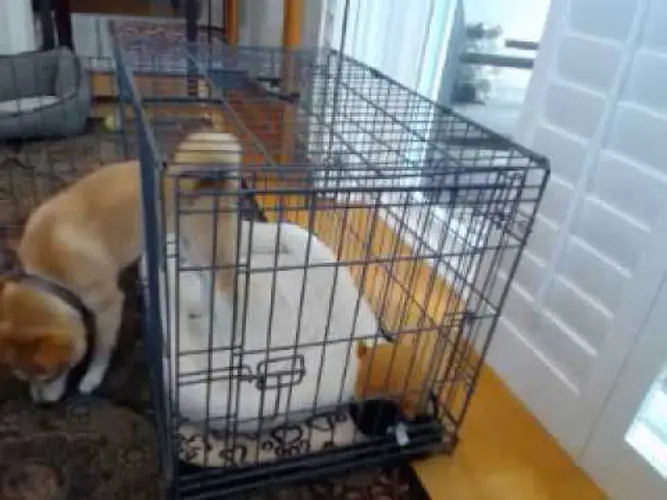
Before delving into the specifics of crate training a Shiba Inu puppy, it’s important to understand the concept behind crate training. Dogs are den animals by nature, and crates mimic the cozy and secure environment of a den. Crate training helps establish boundaries and offers a space where your Shiba Inu can feel safe and relaxed.
Why Crate Training?
Crate training has numerous benefits for both you and your Shiba Inu puppy. Let’s take a closer look at some of the advantages:
- Safe Space: A crate provides a designated area where your puppy can retreat and feel secure whenever they need some alone time or relaxation.
- Travel Convenience: Crate training ensures that your Shiba Inu becomes accustomed to a crate, making travel and vet visits less stressful for both of you.
- Potty Training Aid: By utilizing the crate as part of your potty training routine, you can teach your puppy to hold their bladder and establish a regular elimination schedule.
- Preventing Destructive Behavior: Crates help deter destructive behavior, such as chewing on furniture or getting into hazardous objects, by offering a controlled and secure space.
Now that we’ve explored the benefits of crate training, let’s move on to the step-by-step process.
Step 1: Choosing the Right Crate

Selecting an appropriate crate is crucial for successful crate training. The crate should be large enough for your Shiba Inu puppy to stand, turn around, and lie down comfortably. However, it shouldn’t be too spacious, as excess room may encourage your pup to use one corner for elimination purposes.
Tips for Choosing a Crate:
- Size: Consider your Shiba Inu’s estimated adult size and select a crate that will accommodate their growth. To make a larger crate more suitable for a puppy, you can use dividers to adjust the space accordingly.
- Material: Opt for a sturdy and well-ventilated crate made of materials such as wire, plastic, or collapsible fabric. Ensure there are no sharp edges or parts that could potentially harm your puppy.
- Accessibility: Choose a crate with a secure door latch that is easy to open and close. This will allow you to interact with your Shiba Inu effortlessly and provide a positive association with the crate.
Once you have chosen the right crate, you can move on to the next step in the process.
Step 2: Introducing the Crate
Introducing the crate gradually and positively is key to helping your Shiba Inu puppy develop a favorable association with their new space. Here’s how you can do it effectively:
- Make it Cozy: Line the crate with soft bedding, blankets, or a comfortable crate pad. You want your puppy to feel cozy and comfortable inside.
- Entice with Treats: Place treats, toys, or even meals inside the crate to entice your Shiba Inu. Encourage them to explore the crate willingly by using positive reinforcement.
- Positive Reinforcement: Whenever your puppy enters the crate voluntarily, offer praise and rewards. Make sure they associate entering the crate with positive experiences.
- Encourage Gradual Progress: Initially, keep the crate door open and allow your Shiba Inu to explore at their own pace. Once they are comfortable going in and out freely, you can proceed to the next step.
By introducing the crate in a gradual and positive manner, you’ll foster a sense of security and comfort for your Shiba Inu puppy.
Step 3: Getting Your Puppy Acquainted with the Crate
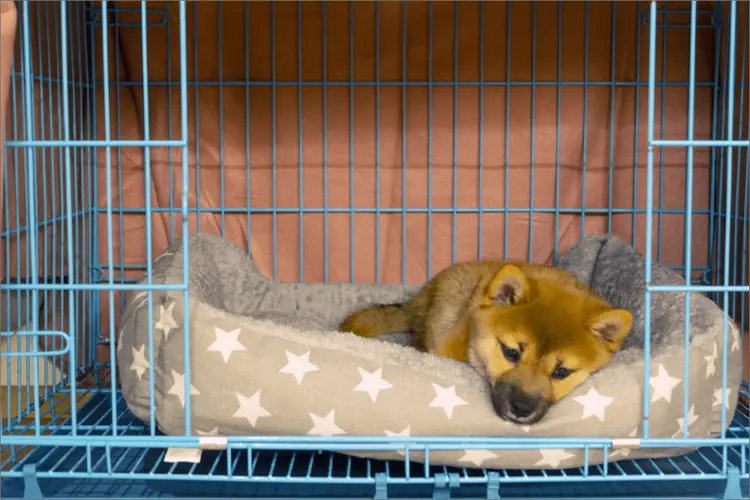
Now that your Shiba Inu puppy has familiarized themselves with the crate, it’s time to take the next step towards crate training. This involves building positive associations and gradually increasing the duration your pup spends inside the crate.
- Mealtime in the Crate: Begin feeding your Shiba Inu their meals near the crate and gradually move the food bowl closer to the crate’s entrance. Eventually, place the bowl inside the crate, encouraging your puppy to eat comfortably inside.
- Closing the Door: After your pup is comfortably eating inside the crate, start closing the door briefly while they are occupied with their meal. Open the door immediately after they finish eating. Gradually increase the duration of door closure, starting with a few seconds and gradually working your way up to several minutes. Always ensure that your puppy remains calm and relaxed during this process.
- Positive Reinforcement: Whenever you close the crate door or open it, use verbal praise and offer treats as rewards. This reinforces positive behavior and helps your Shiba Inu associate the crate with pleasant experiences.
- Quiet Time in the Crate: Encourage your puppy to spend quiet time inside the crate even when they are not eating. Place their favorite toys or chew treats inside to keep them occupied and make the experience enjoyable.
Remember to be patient and consistent throughout the training process. Each puppy learns at their own pace, so avoid rushing or forcing your Shiba Inu into the crate if they seem anxious or resistant. Building trust is key to successful crate training.
Step 4: Nighttime Crating
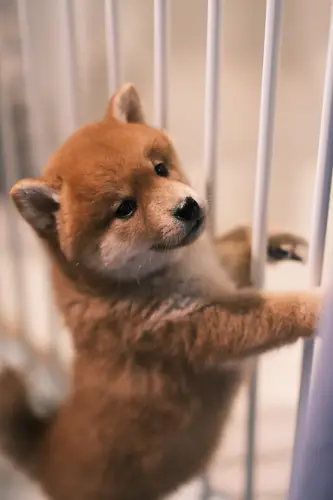
Crate training at night plays a significant role in establishing a routine for your Shiba Inu puppy’s sleep schedule and potty training. Here’s how you can incorporate nighttime crating effectively:
- Bedtime Routine: Create a bedtime routine that includes taking your puppy outside to eliminate before crate time. This will help prevent accidents during the night.
- Calming Environment: Ensure the crate is placed in a quiet area away from excessive noise or distractions. Covering the crate partially with a blanket can create a den-like atmosphere and aid in relaxation.
- Comforting Presence: During the initial nights, place the crate near your bed so that your Shiba Inu can feel your presence. Hearing your heartbeat and smelling your scent will provide comfort and reassurance.
- Gradual Distance: As your puppy becomes more comfortable sleeping in the crate, gradually move the crate to its permanent location. Ensure the new location is still within proximity to you, maintaining a sense of security.
By establishing a consistent nighttime routine and making the crate a positive and secure sleeping space, your Shiba Inu will gradually become accustomed to spending the night in the crate.
Step 5: Accidents and Potty Training
Crate training goes hand in hand with potty training. By utilizing the crate effectively, you can aid in teaching your Shiba Inu puppy proper elimination habits. Here are some tips for successful potty training:
- Scheduled Bathroom Breaks: Establish a regular schedule for taking your puppy outside to eliminate. Take them out first thing in the morning, after meals, before bedtime, and at consistent intervals throughout the day.
- Supervision and Prevention: When your Shiba Inu is not in their crate, ensure close supervision to prevent accidents. Keep a close eye on signs that they may need to eliminate, such as circling or sniffing around.
- Utilize the Crate: When you cannot supervise your puppy closely, place them in the crate for short periods. This prevents accidents and teaches them to hold their bladder until it’s time to go outside.
- Positive Reinforcement: Reward your Shiba Inu with praise and treats when they eliminate in the appropriate area. This reinforces their understanding of where it’s acceptable to relieve themselves.
Remember, consistency, patience, and positive reinforcement are key when it comes to potty training during the crate training process.
Conclusion
Crate training a Shiba Inu puppy is an essential part of their overall training and development. By following these steps and incorporating positive reinforcement, you can successfully crate train your Shiba Inu while building a trusting bond. Remember to be patient, understanding that each puppy learns at their own pace. With time and consistency, your Shiba Inu will view their crate as a safe haven and enjoy the comfort and security it provides.

